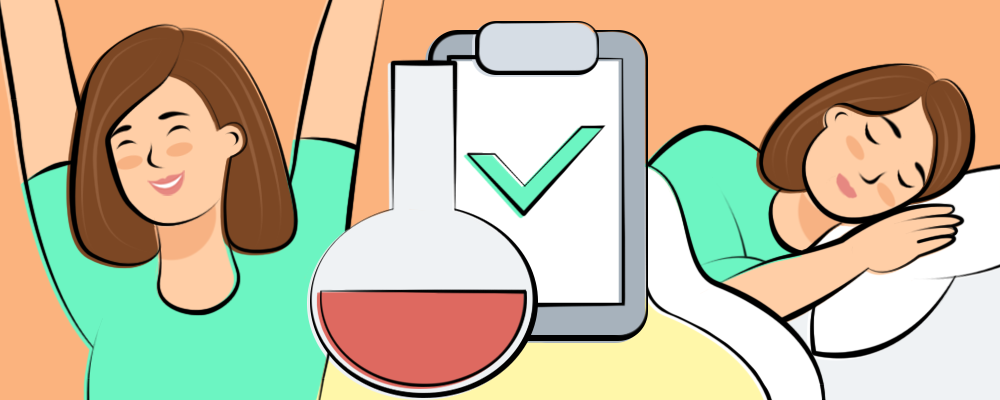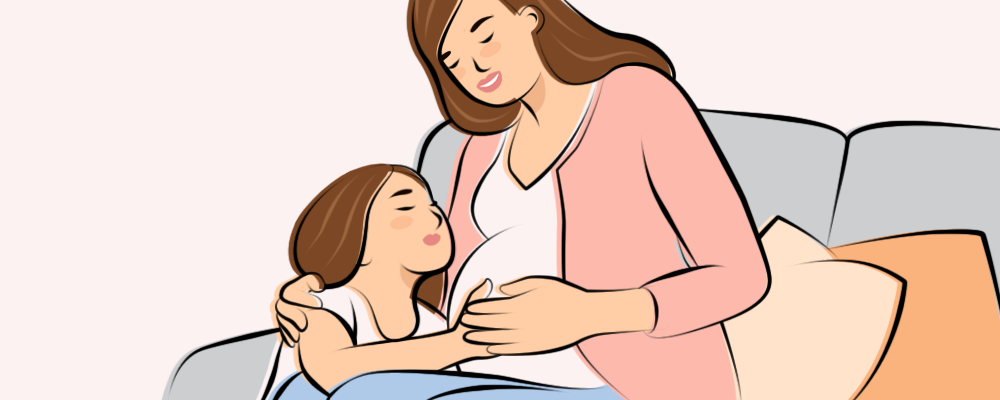Migraines are caused when the normal balance of the brain is pushed so much out of center that it
reaches a tipping point. At this tipping point (also called “the migraine threshold”), a biochemical chain
reaction starts that gradually picks up speed and ends in a migraine attack. To visualize this, imagine a Jenga tower where each block represents a factor that is important for your brain to be in balance:
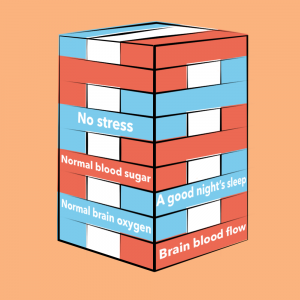
If you remove one block, the tower will still be somewhat stable.

But the more blocks you remove (especially the more important ones at the bottom) the closer you get to the tipping point.
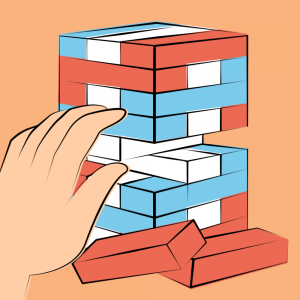
At this point, removing just one block makes the entire tower tumble.
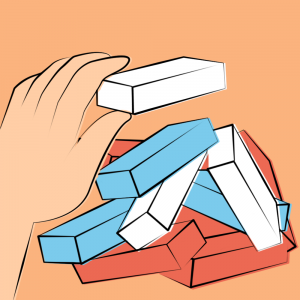
Some people are born with brains that have a very high tipping point, meaning that they may never come so much out of balance that they experience a migraine attack. In others, the threshold is lower, meaning that just removing a couple of blocks (for example the block “A good night’s sleep” and “No stress”) can be enough to start the biochemical chain reaction that leads to a migraine attack. These people are migraine patients.
The point when the tower tumbles down is when a migraine attack is triggered. This starts a chain reaction at one specific place in the brain, and then spreads out like ripples in a lake.
To visualize this, imagine that our Jenga tower is standing next to a row of domino pieces:
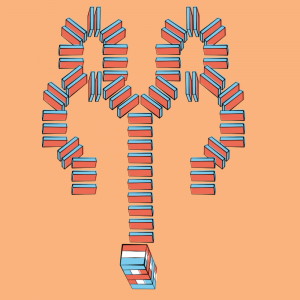
The domino bricks are red on one side, so that when a piece falls down, the red side faces upward. In this example we can imagine that the red color is a signal that something is wrong:
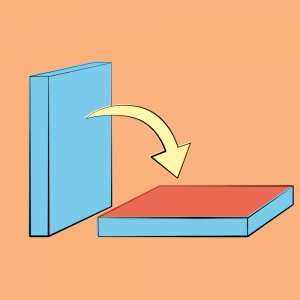
When the Jenga tower tumbles down, it knocks over the first of the domino pieces (“A” in the figure), which will then knock over the next, and so on until all the domino pieces have fallen down and almost the whole table is bright red:
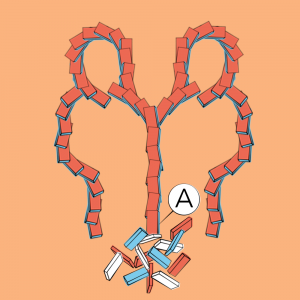
In this example, the red/blue domino bricks represent the brain’s nerve cells. When a migraine attack is triggered (represented by the Jenga tower falling down), a chain reaction starts that spreads to more and more neurons until in the end a huge number of them have been knocked out of a balance (represented by the red color) and started the headache, nausea and other migraine symptoms.
In the article you can read more details about how this chain reaction starts and jumps from nerve cell to nerve cell in the brain.
What can trigger a migraine attack?
Anything that disturbs the brain’s normal balance can potentially be a migraine trigger. Triggers that are especially strong are those that disturb the brain’s energy level, since the brain need a constant supply of energy to stabilize itself and keep its normal balance.
The brain’s energy comes from the oxygen and blood sugar that is delivered to it by the blood, and because of that migraine can be triggered by:
- A poor blood supply to the brain, for example if the blood vessels contract
- A low oxygen content in the blood, for example if you are at a high altitude
- A low content of blood sugar in the blood, for example if it is too long since you ate a meal
The brain’s energy level can also become low if you haven’t slept for a long time or if your brain has been working very hard for a long time, as can happen when you are stressed, sick or otherwise out of balance.
Why do only some people get migraines?
It is well known that migraine to some extent tends to run in families, and in scientific studies it has been found that about 50% of the risk of being a migraine patient comes from genes and the other 50% from other factors.
Each gene has a particular job to do in the body, so an error in a gene will often mean that its job is not done, or not done as well as it should be. Scientific studies have pin-pointed some particular gene errors that seem to be more common in migraine patients.
The genetic connection is particularly strong in one rare type of migraine called Familial Hemiplegic Migraine (FHM) which affects about 1 in 10.000 people. FHM can be caused by three specific gene errors. It is an important clue to the cause of migraine in general that these three genes are normally responsible for transporting ions (ions = molecules that electrically charged) in and out of nerve cells. In FHM patients, the gene errors make this transport less precise and efficient, meaning that the migraine threshold is much lower – in other words the “Jenga tower” is in these patients much less stable.
For the more common types of migraine (Migraine with Aura (MA) and Migraine without Aura (MO)), the connection with genes is not as strong as for FHM, but studies have found some gene types that are more common in migraine patients. For MA and MO it seems that many genes work together to decide if someone becomes a migraine patient, so it is harder to point to one genetic “smoking gun” as the cause.
However, there are other ways that migraine patients seem to be different from people without migraine:
Firstly, migraine patients seem to have brains that on a day-to-day basis are more “excitable”, meaning that they respond more strongly to an input or stimulus. Your brain’s level of excitability can be tested by having you look at a changing pattern on a screen while a sensor measures the magnetic fields produced by your brain. If you are a migraine patient those magnetic fields will on average be stronger than a “normal” person.
Also, studies have shown that the brains of migraine patients seem not to “get used to” a stimulus when it is repeated, whereas in normal people the brain’s reaction to the same stimulus will get smaller and smaller for each time the stimulus is repeated.
Overall, these differences mean that the brain of a migraine patient in general will be more hyperactive. Whenever a nerve cell is activated (also called that it “fires”), the biochemical balance of the brain is disturbed a little bit, so a brain that is hyperactive will be more likely to be pushed so far out of its normal balance that it results in a migraine attack.
It is known from several very large studies that some illnesses are more common among migraine patients, including depression, anxiety, epilepsy and stroke, and the difference in excitability may be one of the reasons.
Finally, gender is well-known to be important for the risk of migraine. Even though boys and girls are equally likely to have migraine, after puberty migraine is two to three times more common in women than men. One of the most important changes in girls at puberty is in the levels of female sex hormones, so it seems likely that these hormones play a role for triggering migraines. However, some of this gender difference may be a bit misleading: women are on average more likely to seek medical help for their migraines, and men with migraine are on average somewhat less likely to be given the diagnosis of migraine, perhaps because of the idea that migraine is a “woman’s disease”. This means that the number of men with migraine may be underestimated, though it is certain that women are more at risk of migraine than men.
The reason for the sex difference in migraine is not known for certain, but part of the explanation may be the difference in how female and male sex hormones affect the brain’s excitability. In animal studies, the female sex hormone estrogen seems to make the brain more excitable and vulnerable to triggering cortical spreading depression while the male sex hormone testosterone has the opposite effect.
Another reason may be the fact that women’s hormone levels are changing much more than men’s on a monthly basis: some studies indicated that it is these changes in hormone levels that are responsible for triggering migraine.
